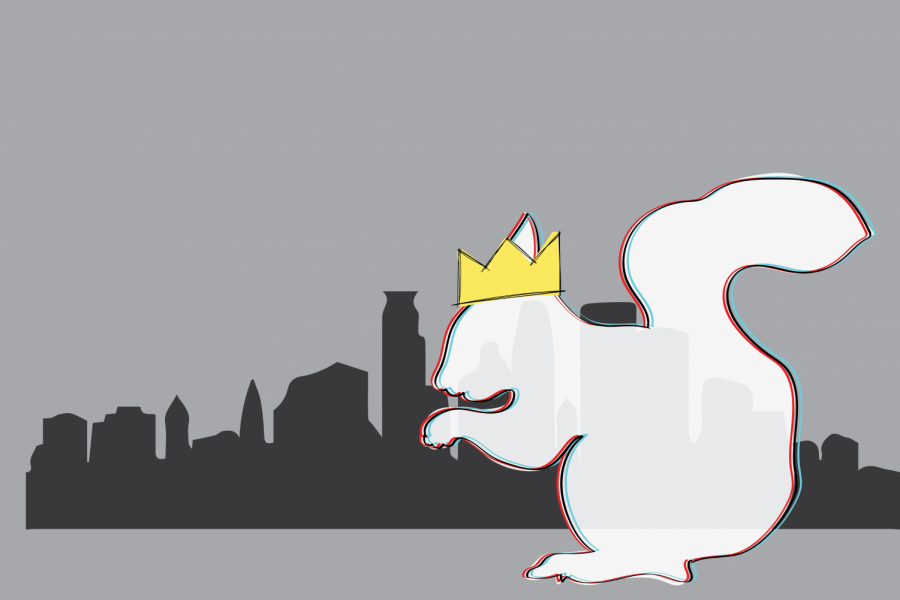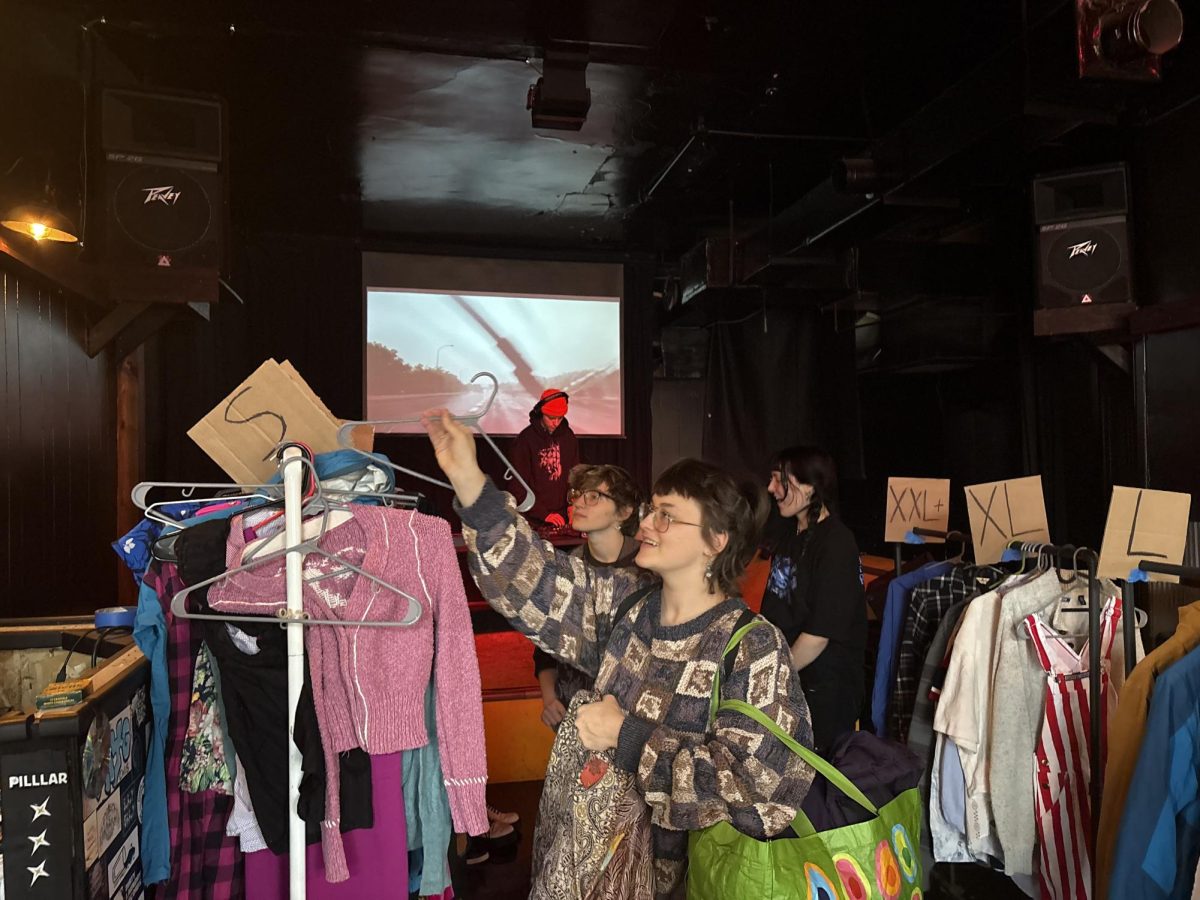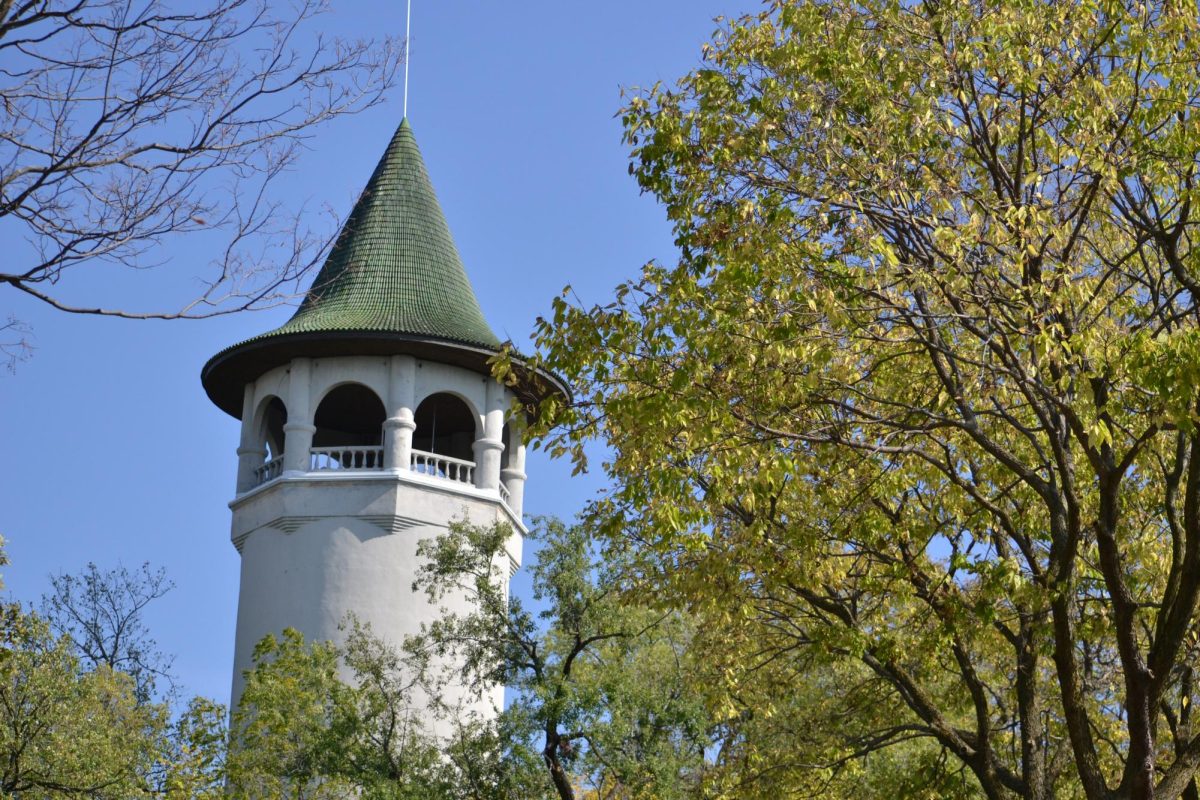It’s an unusually warm afternoon in spring of 2020, and University of Minnesota graduate Colin Vehmeier sits at a picnic table in Van Cleve Park, Cuban sandwich and a yerba mate tea in hand. A few bites into his meal, Vehmeier notices that he’s not alone. “This one squirrel comes up behind me … like it was probably within a foot of me,” he said. “It had its eyes on the sandwich.”
To Vehmeier’s surprise, the squirrel brought reinforcements. “Now I have a squirrel on my table, a squirrel behind me and then one sitting next to me,” he said, “and I’m not doing well.”
After a total of eight squirrels had surrounded his table, Vehmeier surrendered the rest of his sandwich and left the park. “That’s their turf, and I learned not to mess with them,” he explained. “I felt like their motives were sinister.”
Apprehending the sandwich of an unsuspecting picnic-goer, taking off with a student’s lab notebook and cracking open a White Claw for happy hour — for a squirrel at the University, this is just another day in the life.
Big, brave and bushy-tailed, the campus squirrels are far from average. Their infamy at the University can be accredited to their mischievous antics, resulting in funny anecdotes and minor inconveniences for students. Whether they’re plotting a food heist or popping out of a trash can, it’s obvious that these city critters exhibit vastly different behavior than their rural counterparts. Nurture and nature combine in this tale of urbanization, as human influence works in tandem with physiology to create these fuzzy “urban exploiters.”
Move over, gophers — the squirrels just might be the real alpha rodents on campus.
Goldy gopher or Goldy ground squirrel?
The legacy of squirrels on campus extends far beyond their daring escapades. In fact, they play an interesting role in the University’s history, dating back over a century.
After graduating from the University in 2008, Ryan Barland went on to become an oral historian at the Minnesota Historical Society. The intersection between his love for sports and history has evolved into a unique area of expertise for Barland, especially when it comes to the Golden Gophers.
Barland explained that there’s more to Goldy Gopher — the beloved, buck-toothed face of the University — than his name might suggest. The mystery originated in the 1800s with a political scandal, railroad tycoons and a certain discrepancy in a newspaper cartoon involving none other than the squirrels themselves.
In 1857, a land grant bill was proposed to the Minnesota legislature that would authorize a $5 million loan to be used for the construction of railroads. The railroad companies at the receiving end of this grant were headed by prominent political figures, including representatives and leaders from both parties. Due to the railroad tycoons’ political prowess and hand in the legislature, the bill was passed with ease.
In opposition to this, a Saint Paul resident named Robert Ormsby Sweeny crafted a political cartoon depicting advocates of the bill as striped “gophers” pulling a cart across a railroad. Supporting the tracks from underneath are nine men with bags of money around their necks, which represent legislators who were allegedly bribed to support the passage of the bill.
Because of this, Minnesota became known as the “Gopher State,” Barland said, which ultimately led to the University’s adoption of the moniker and mascot. But there was a major discrepancy in the cartoon that was overlooked before its circulation and subsequent infamy; although Sweeny labeled them as “gophers,” the critters he depicted were actually 13-lined ground squirrels.
They’re not chipmunks, and they’re certainly not gophers — these often-misidentified ground squirrels are a species of their own. Their backs and tails are decorated with a distinct striped pattern, almost identical to that seen on the tail of the University’s fearless mascot.
“I don’t think the ‘University of Minnesota Squirrels’ has quite the same ring to it,” Barland said. “The ship had already sailed at that point, and everyone was pretty on board with the gopher name.”
Happy hours, heists and other hijinks
Whether or not you embrace his true identity, Goldy’s backstory makes one thing clear: squirrels are a part of the University’s roots. They’re not going anywhere anytime soon, and they’re not afraid to make their presence known.
“I once saw a squirrel trying to drink a White Claw that was left out on my deck,” said Alyssa Arnold, a third-year student at the University. If you’re from outside the city, this behavior might come as a surprise. Maybe you’re used to seeing squirrels hide acorns away for later, but probably not alcoholic seltzers.
These squirrels are interested in more than just cocktails, though — they’re here to wine and dine, and in a similar fashion to college students, they’ll do whatever it takes to get their paws on some free food. Avery Wageman, a senior majoring in communication studies, said she “once saw one steal a slice of pizza out of a garbage can and then climb a power line to eat it.”
Barrett Seeley, a second-year neuroscience major, experienced this tenacity first-hand. She was sitting outside after purchasing school supplies at Coffman Memorial Union, and decided to leave her belongings behind while she went in to use the bathroom. When she returned, Seeley said she was shocked to see a particularly “buff” campus squirrel running away with her chemistry lab notebook.
“It’s my first year on campus, so it was a bit shocking because all the squirrels in the suburbs are super small and they don’t interact with people,” she said.
Although she had to buy a new notebook, Seeley said this encounter painted the campus squirrels in a positive light for her. “It just shows their resilience when they want to complete a task,” Seeley said.
To habituate or not to habituate
The explanation behind this sort of behavior boils down to the physiology of squirrels on campus.
Charlotte Devitz is working toward her doctorate in ecology, evolution and behavior. Her dissertation is focused on how urbanization affects wildlife; specifically, how certain behavioral traits facilitate adaptation to urban environments.
Devitz chose to conduct her research on squirrels, referring to them as “urban exploiters.” She noted that they take advantage of novel resources that being on campus provides, like increased food availability. “They’re so used to being fed by people that they’re pretty relentless,” she said.
Devitz noted that one of the larger behavioral differences in urban squirrels compared to those in rural areas is their comfort level around people. “They basically just become habituated to the presence of people,” she said. “Similarly, they’re a lot more bold with stealing food and their willingness to interact with things that aren’t natural.”
According to Devitz, this habituation to people and other potential threats is beneficial for their immune system and other physiological functions.
She explained that if someone walked through a rural site with a dog that started lunging at a squirrel, the squirrel would mount a stress response, which is an extremely energy-costly process. Urbanization increases the frequency at which squirrels come in contact with such threats; if they mount a stress response every time one appears, this frequency could have a “whole cascade of physiological effects.”
“It can affect their ability to go on and reproduce … it can weaken immune function for them,” Devitz said. Thus, the city squirrels have to habituate and learn that these things aren’t always going to kill them. “Obviously there is still risk involved because there could be a dog that does come after them … so it’s a balancing of risks. But in most cases, it’s going to be beneficial for those animals to habituate,” she said.
On the flip side, this habituation might be less of a benefit and more of a nuisance for students. But if a squirrel ever stares you down for a bite of food, Devitz has some advice.
“If you ignore them long enough, and just try and run away, they might leave you alone,” she said. “You might not have to leave your Cuban sandwich for them, but who knows.”















Mateo
Sep 21, 2021 at 1:39 pm
I am very old but, if anyone remembers The Network column that ran in The Daily, sometime in The Mid-Nineties (possibly earlier) they, via an early version of, I guess, crowdsourcing, established with little room for doubt that the squirrels most certainly ran The Empire (as The U had become known to readers of The Network). I don’t know if those old columns are archived somewhere. Once found, you’ll have all the evidence you need, along with dissertations on why never white pants before Labor Day and the pardoning of my taco.